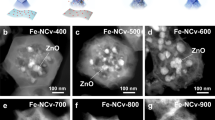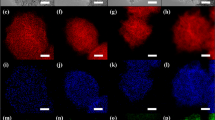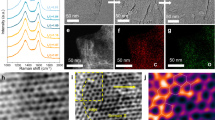Abstract
Owing to the difficulty in controlling the dopant or defect types and their homogeneity in carbon materials, it is still a controversial issue to identify the active sites of carbon-based metal-free catalysts. Here we report a proof-of-concept study on the active-site evaluation for a highly oriented pyrolytic graphite catalyst with specific pentagon carbon defective patterns (D-HOPG). It is demonstrated that specific carbon defect types (an edged pentagon in this work) could be selectively created via controllable nitrogen doping. Work-function analyses coupled with macro and micro-electrochemical performance measurements suggest that the pentagon defects in D-HOPG served as major active sites for the acidic oxygen reduction reaction, even much superior to the pyridinic nitrogen sites in nitrogen-doped highly oriented pyrolytic graphite. This work enables us to elucidate the relative importance of the specific carbon defects versus nitrogen-dopant species and their respective contributions to the observed overall acidic oxygen reduction reaction activity.
This is a preview of subscription content, access via your institution
Access options
Access Nature and 54 other Nature Portfolio journals
Get Nature+, our best-value online-access subscription
$29.99 / 30 days
cancel any time
Subscribe to this journal
Receive 12 digital issues and online access to articles
$119.00 per year
only $9.92 per issue
Buy this article
- Purchase on Springer Link
- Instant access to full article PDF
Prices may be subject to local taxes which are calculated during checkout





Similar content being viewed by others
Data availability
The data that support the plots within this paper and other findings of this study are available from the corresponding author upon reasonable request.
References
Gong, K. P., Du, F., Xia, Z. H., Durstock, M. & Dai, L. M. Nitrogen-doped carbon nanotube arrays with high electrocatalytic activity for oxygen reduction. Science 323, 760–764 (2009).
Kurak, K. A. & Anderson, A. B. Nitrogen-treated graphite and oxygen electroreduction on pyridinic edge sites. J. Phys. Chem. C 113, 6730–6734 (2009).
Kundu, S. et al. Electrocatalytic activity and stability of nitrogen-containing carbon nanotubes in the oxygen reduction reaction. J. Phys. Chem. C 113, 14302–14310 (2009).
Geng, D. S. et al. High oxygen-reduction activity and durability of nitrogen-doped graphene. Energy Environ. Sci. 4, 760–764 (2011).
Zhang, L. P. & Xia, Z. H. Mechanisms of oxygen reduction reaction on nitrogen-doped graphene for fuel cells. J. Phys. Chem. C 115, 11170–11176 (2011).
Yasuda, S., Yu, L., Kim, J. & Murakoshi, K. Selective nitrogen doping in graphene for oxygen reduction reactions. Chem. Commun. 49, 9627–9629 (2013).
Zheng, B., Wang, J., Wang, F. B. & Xia, X. H. Synthesis of nitrogen doped graphene with high electrocatalytic activity toward oxygen reduction reaction. Electrochem. Commun. 28, 24–26 (2013).
Jiao, Y., Zheng, Y., Jaroniec, M. & Qiao, S. Z. Origin of the electrocatalytic oxygen reduction activity of graphene-based catalysts: a roadmap to achieve the best performance. J. Am. Chem. Soc. 136, 4394–4403 (2014).
Wu, J. J. et al. Nitrogen-doped graphene with pyridinic dominance as a highly active and stable electrocatalyst for oxygen reduction. ACS Appl. Mater. Interfaces 7, 14763–14769 (2015).
Liu, X. & Dai, L. M. Carbon-based metal-free catalysts. Nat. Rev. Mater. 1, 16064 (2016).
Rao, C. V., Cabrera, C. R. & Ishikawa, Y. In search of the active site in nitrogen-doped carbon nanotube electrodes for the oxygen reduction reaction. J. Phys. Chem. Lett. 1, 2622–2627 (2010).
Lai, L. F. et al. Exploration of the active center structure of nitrogen-doped graphene-based catalysts for oxygen reduction reaction. Energy Environ. Sci. 5, 7936–7942 (2012).
Niwa, H. et al. X-ray absorption analysis of nitrogen contribution to oxygen reduction reaction in carbon alloy cathode catalysts for polymer electrolyte fuel cells. J. Power Sources 187, 93–97 (2009).
Liu, R. L., Wu, D. Q., Feng, X. L. & Mullen, K. Nitrogen-doped ordered mesoporous graphitic arrays with high electrocatalytic activity for oxygen reduction. Angew. Chem. Int. Ed. 49, 2565–2569 (2010).
Lin, Z. Y., Waller, G. H., Liu, Y., Liu, M. L. & Wong, C. P. 3D nitrogen-doped graphene prepared by pyrolysis of graphene oxide with polypyrrole for electrocatalysis of oxygen reduction reaction. Nano Energy 2, 241–248 (2013).
Guo, D. H. et al. Active sites of nitrogen-doped carbon materials for oxygen reduction reaction clarified using model catalysts. Science 351, 361–365 (2016).
Jia, Y., Chen, J. & Yao, X. D. Defect electrocatalytic mechanism: concept, topological structure and perspective. Mat. Chem. Front. 2, 1250–1268 (2018).
Banhart, F., Kotakoski, J. & Krasheninnikov, A. V. Structural defects in graphene. ACS Nano 5, 26–41 (2011).
Hou, Z. F. et al. Electronic structure of N-doped graphene with native point defects. Phys. Rev. B 87, 165401 (2013).
Tang, C. et al. Topological defects in metal-free nanocarbon for oxygen electrocatalysis. Adv. Mater. 28, 6845–6851 (2016).
Tao, L. et al. Edge-rich and dopant-free graphene as a highly efficient metal-free electrocatalyst for the oxygen reduction reaction. Chem. Commun. 52, 2764–2767 (2016).
Jiang, Y. F. et al. Significant contribution of intrinsic carbon defects to oxygen reduction activity. ACS Catal. 5, 6707–6712 (2015).
Jia, Y. et al. Defect graphene as a trifunctional catalyst for electrochemical reactions. Adv. Mater. 28, 9532–9538 (2016).
Rauf, M. et al. Insight into the different ORR catalytic activity of Fe/N/C between acidic and alkaline media: protonation of pyridinic nitrogen. Electrochem. Commun. 73, 71–74 (2016).
Yan, D. F. et al. Defect chemistry of nonprecious-metal electrocatalysts for oxygen reactions. Adv. Mater. 29, 1606459 (2017).
Ji, L. W. et al. Graphene oxide as a sulfur immobilizer in high performance lithium/sulfur cells. J. Am. Chem. Soc. 133, 18522–18525 (2011).
Cheon, J. Y. et al. Intrinsic relationship between enhanced oxygen reduction reaction activity and nanoscale work function of doped carbons. J. Am. Chem. Soc. 136, 8875–8878 (2014).
Zhang, L. P., Xu, Q., Niu, J. B. & Xia, Z. H. Role of lattice defects in catalytic activities of graphene clusters for fuel cells. Phys. Chem. Chem. Phys. 17, 16733–16743 (2015).
Hong, M., Chen, J. W. & Chen, E. Y.-X. Polymerization of polar monomers mediated by main-group Lewis acid–base pairs. Chem. Rev. 118, 10551–10616 (2018).
Shen, A. L. et al. Oxygen reduction reaction in a droplet on graphite: direct evidence that the edge is more active than the basal plane. Angew. Chem. Int. Ed. 53, 10804–10808 (2014).
Lucchese, M. M. et al. Quantifying ion-induced defects and Raman relaxation length in graphene. Carbon 48, 1592–1597 (2010).
Kresse, G. & Furthmuller, J. Efficiency of ab-initio total energy calculations for metals and semiconductors using a plane-wave basis set. Comput. Mater. Sci. 6, 15–50 (1996).
Kresse, G. & Furthmuller, J. Efficient iterative schemes for ab initio total-energy calculations using a plane-wave basis set. Phys. Rev. B 54, 11169–11186 (1996).
Perdew, J. P., Burke, K. & Ernzerhof, M. Generalized gradient approximation made simple. Phys. Rev. Lett. 77, 3865–3868 (1996).
Li, D. et al. A defect-driven metal-free electrocatalyst for oxygen reduction in acidic electrolyte. Chem 4, 2345–2356 (2018).
Valdes, A., Qu, Z. W., Kroes, G. J., Rossmeisl, J. & Norskov, J. K. Oxidation and photo-oxidation of water on TiO2 surface. J. Phys. Chem. C 112, 9872–9879 (2008).
Acknowledgements
The authors thank the Australia Research Council for financial support (ARC DP170103317, ARC DP170102267 and ARC DP190103881). Y.J. also thanks the ARC for an ARC Discovery Early Career Researcher Award (ARC DE180101030). The authors thank the Australian National Fabrication Facility (ANFF)—Materials Node, the University of Wollongong Electron Microscopy Centre and Canadian Light Source for equipment access.
Author information
Authors and Affiliations
Contributions
X.Y. and L.D. conceived and designed the project. X.Y. supervised the project. Y.J. and L.Zhang prepared the samples and did the electrocatalytic performances test. L.Zhang, L.Zhuang, X.Y. and Z.Z. performed the characterizations, which included XPS, scanning electron microscopy and Raman spectroscopy. J.W. did the XAS. J.C. performed the transition electron microscopy. X.W., J.L. and Y.Z. performed PA. E.T. did the AFM. Z.X. and S.W. performed the micro-electrocatalytic measurements. H.L. and D.Y. performed the DFT calculations. Y.J., L.Zhang, X.Y. and L.D. wrote the manuscript. Y.J. and L.Zhang contributed equally to this work. All the authors discussed the results and commented on the manuscript.
Corresponding authors
Ethics declarations
Competing interests
The authors declare no competing interests.
Additional information
Publisher’s note: Springer Nature remains neutral with regard to jurisdictional claims in published maps and institutional affiliations.
Supplementary information
Supplementary Information
Supplementary Figs. 1–11 and Supplementary Table 1.
Rights and permissions
About this article
Cite this article
Jia, Y., Zhang, L., Zhuang, L. et al. Identification of active sites for acidic oxygen reduction on carbon catalysts with and without nitrogen doping. Nat Catal 2, 688–695 (2019). https://doi.org/10.1038/s41929-019-0297-4
Received:
Accepted:
Published:
Issue Date:
DOI: https://doi.org/10.1038/s41929-019-0297-4
This article is cited by
-
Site-specific reactivity of stepped Pt surfaces driven by stress release
Nature (2024)
-
Data-driven rational design of single-atom materials for hydrogen evolution and sensing
Nano Research (2024)
-
Defect spinel oxides for electrocatalytic reduction reactions
Nano Research (2024)
-
Melamine–Formaldehyde Resin Derived Carbon Catalysts with Abundant Intrinsic Defects to Afford Superior Oxygen Reduction Activity
Catalysis Letters (2024)
-
Recent Advances in Mechanistic Understanding of Metal-Free Carbon Thermocatalysis and Electrocatalysis with Model Molecules
Nano-Micro Letters (2024)



